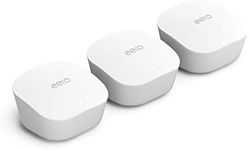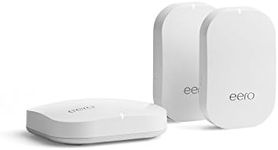Buying Guide for the Best Long Range Wifi Extenders
Choosing a long-range WiFi extender can make a big difference in how well your wireless network covers your home or office. The main goal is to boost your existing WiFi signal so it reaches areas that are currently weak or have no coverage at all. To find the best fit, you should think about the size of the area you want to cover, the layout of your space, and the types of devices you plan to connect. Understanding the key features will help you make a smart choice that matches your needs.Range CoverageRange coverage tells you how far the WiFi extender can spread your wireless signal. This is important because it determines whether the extender can reach the areas where your WiFi is weak. Extenders are usually rated for small, medium, or large spaces. Small coverage is good for single rooms or apartments, medium for multi-room homes, and large for big houses or offices. To pick the right one, think about the size and layout of your space and where you need better WiFi. If you have thick walls or multiple floors, you may need a model with higher range coverage.
WiFi Standard (e.g., WiFi 5, WiFi 6)The WiFi standard refers to the technology the extender uses to communicate with your devices and router. Newer standards like WiFi 6 offer faster speeds, better performance with many devices, and improved efficiency. Older standards like WiFi 4 or WiFi 5 are still common and work well for basic needs. If you have newer devices or want the best performance, look for an extender that matches your router’s standard, especially if it supports WiFi 6. For basic browsing or older devices, WiFi 5 may be enough.
Speed RatingSpeed rating shows the maximum data rate the extender can handle, usually measured in Mbps or Gbps. This matters because it affects how fast your internet will feel in the extended area. Lower speeds (under 600 Mbps) are fine for web browsing and email, mid-range speeds (600-1200 Mbps) are good for streaming and gaming, and higher speeds (over 1200 Mbps) are best for heavy use or many devices. Choose a speed that matches your internet plan and how you use the internet in the area you want to cover.
Frequency Bands (Single, Dual, or Tri-Band)Frequency bands refer to the channels the extender uses to send and receive data. Single-band extenders use only the 2.4GHz band, which is slower but has longer range. Dual-band extenders use both 2.4GHz and 5GHz, offering better speed and less interference. Tri-band extenders add an extra 5GHz band for even more performance, especially in busy homes. If you have many devices or do a lot of streaming and gaming, dual or tri-band is better. For simple needs, single-band may be enough.
Ethernet PortsEthernet ports let you connect devices directly to the extender with a cable for a more stable and faster connection. This is useful for things like smart TVs, gaming consoles, or desktop computers. Some extenders have no ports, some have one, and others have several. If you want to connect wired devices, look for an extender with enough Ethernet ports for your needs.
Setup and CompatibilitySetup and compatibility describe how easy it is to install the extender and whether it works with your existing router and devices. Some extenders have simple setup processes with apps or one-button connections, while others may require more steps. Most modern extenders are compatible with any router, but it’s good to check. If you’re not comfortable with technology, look for models that advertise easy setup.
Antenna DesignAntenna design affects how well the extender can send and receive signals. Some have internal antennas for a cleaner look, while others have external, adjustable antennas for better range and flexibility. If you need to direct the signal to specific areas or through walls, external antennas can help. For open spaces or simple setups, internal antennas may be enough.
















